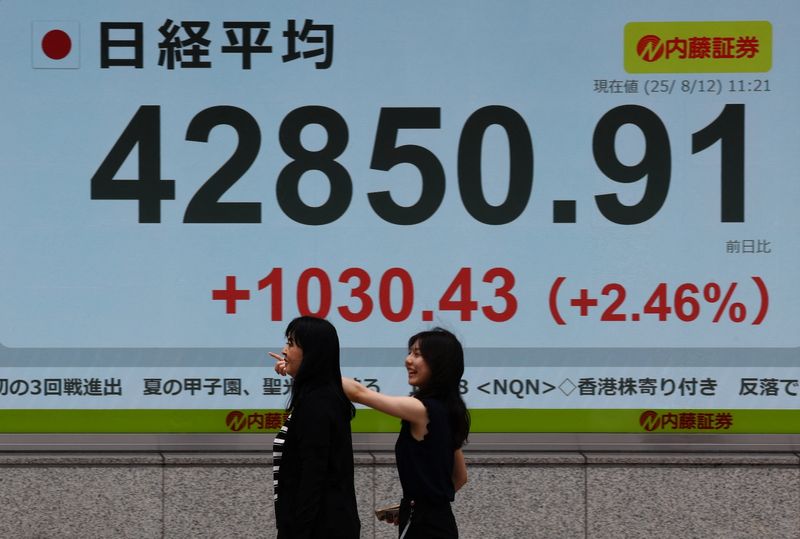
By Gregor Stuart Hunter
SINGAPORE (Reuters) -Stocks in Asia edged higher in a shaky start on Friday as anxious traders awaited a speech from Federal Reserve Chair Jerome Powell at the annual Jackson Hole symposium.
Financial markets are looking out for Powell to provide clues about the likelihood of a September rate cut in the wake of recent signs of job market weakness and the near term outlook for policy. "Markets are on edge ahead of the all-important Jackson Hole speech," said Carol Kong, an economist and currency strategist at Commonwealth Bank of Australia in Sydney.
MSCI's broadest index of Asia-Pacific shares outside Japan gained 0.2%, extending its climb to 1.6% so far this month. South Korea's Kospi index led the charge, rising 1%, while China's blue-chip CSI 300 Index was on track for a third consecutive day of gains. The Nikkei 225 veered between gains and losses, and was last up 0.1%.
The yen held steady at 148.45 against the U.S. dollar after data showed Japan's core consumer prices in July exceeded analysts' estimates and the Bank of Japan's inflation target.
The U.S. dollar index, which tracks the greenback against a basket of currencies of major trading partners, was steady at 98.60 after four consecutive days of gains, as traders parsed speeches from Fed officials who appeared lukewarmto the idea of an interest rate cut next month.
S&P 500 futures were up 0.1%. The cash gauge on Wall Street is on a five-day losing streak, which has left it on track for its biggest one-week decline this month.
Traders had ramped up bets for a September cut following a surprisingly weak payrolls report at the start of this month, and after consumer price data showed limited upward pressure from tariffs.
However, market pricing pulled back slightly following the release of minutes from the Fed's July meeting. Traders are now pricing in a 75% probability of a cut in September, down from 82.4% on Thursday, according to the CME Group's FedWatch tool. The most likely scenario is that Powell won't provide "any definitive clues" on what the Fed will do next ahead of critical non-farm payrolls and CPI data, Kong said.
"Given where the current market is, the risk is a stronger U.S. dollar, especially if he challenges the current market pricing of a 25-basis-point cut." Traders are assessing signs that U.S. economic activity picked up pace in August, with PMI data from S&P Global showing the strongest growth in manufacturing orders in 18 months.
But the labour market also highlighted pockets of weakness, as the number of Americans filing new applications for jobless benefits rose by the most in about three months last week and the number of people collecting unemployment relief in the prior week climbed to the highest level in nearly four years. The dollar held steady against the euro at $1.1607 as the EU and the U.S. set out details of a framework trade deal struck in July. Oil prices moved lower, with Brent crude last trading down 0.3% at $67.45 per barrel, after strong gains on Thursday as Russia and Ukraine blamed each other for a stalled peace process, and U.S. data showed signs of strong demand in the top oil consuming nation. Gold was slightly lower, with spot bullion off 0.1% at $3334.20 per troy ounce. [GOL/]
(Reporting by Gregor Stuart Hunter;Editing by Shri Navaratnam)

 Reuters US Economy
Reuters US Economy
 Reuters US Business
Reuters US Business Business of Home
Business of Home CNN
CNN Just Jared
Just Jared Essentiallysports Football
Essentiallysports Football Associated Press Top News
Associated Press Top News Chicago Tribune Crime
Chicago Tribune Crime